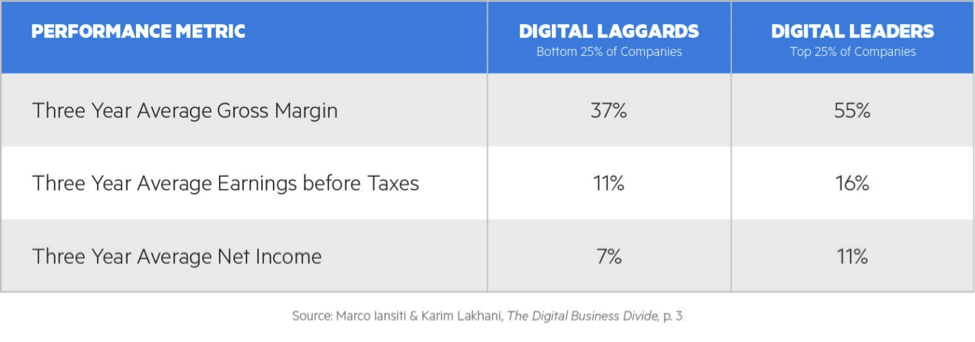Digital transformation is everywhere these days. From TV commercials to boardrooms, everything is becoming digital. However, at the same time, companies in all industries are feeling the pressure of disruption and an uncertain future. By the end of last year, two-thirds of Global 2000 CEOs had digital transformation at the center of their strategy [i]—but along with that comes the angst that the effort can cause.
All organizational change is difficult. But the actions demanded of organizations making the shift to digital can often prove too much for even the most agile and dynamic organizations. Many organizations are learning the hard truths about digital transformations, and the numbers aren’t pretty. Nearly half of the senior executives polled by Wipro Digital in 2017 believe their company isn’t successfully executing 50 percent of their digital strategies. One in five say their company’s digital transformation is a waste of time.
Another review of the state of digital transformation estimates nearly 84 percent of companies appear to fail at it. [ii]
So why are most digital transformation initiatives so unsuccessful?
There are many reasons given in the Wipro Digital study, and they include a wide range of culprits from business alignment, doubts and support of management to focusing on operational over innovation activities.
But I would suggest there is a deeper root cause: complexity—an often unacknowledged killer when it comes to digital transformation success. In fact, complexity is likely more of a root cause than all the cultural and leadership challenges when it comes to successful digital transformation initiatives.
Since digital transformations are driven by underlying technology initiatives, let’s look at how complexity impacts digital transformation.
For many organizations embarking on digital transformation initiatives, that means technology acquisition. The siren song of readily available open source offerings and demand for new capabilities means organizations are bringing new technology in house at an increasing rate. The trend is set to accelerate; in a study released earlier this year by Dynatrace, 53% of CIOs planning to deploy even more technologies in the next 12 months.
So how does the adoption of new technologies heighten complexity?
According to the same Dynatrace study, a single web or mobile transaction touches 35 different technology systems or applications, as compared with 22 components just five years ago.
In another study conducted by Neuralytics, the random collection of open source technologies collected by companies for each project can lead to 3 times the number of hours required to complete a single project than with a unified platform.
When you multiply the expanded hours per project with multiple connectivity demands across the dozens, if not hundreds, of projects that make up a typical digital transformation effort, you have a complexity nightmare.
In the prophetic words of Mihai Strusievici, director of IT, North America at Colliers International, a global real estate services company, “We created these monsters that were supposed to do everything under the sun, and guess what? With complexity, you diminish your ability to deliver anything pleasant, and it’s very difficult to support.” [iii]
And when you diminish your ability to deliver, all the other leadership and cultural problems begin to rear their heads. Failures lead to morale problems, questioning the investments in digital, embarrassed executives and angry boards.
The goal is to take a step back and simplify activities and initiatives that relate to digital transformation.
So how do you actually simplify your activities?
For starters, don’t ignore primary business metrics. Digital transformation doesn’t suspend the laws of commerce. As noted in the Neuralytics study, point solutions take longer to develop on and have a higher total cost of ownership (TCO) than unified platforms. Don’t let some shiny new single technology lure you away from sound business logic. The fewer systems you can use to develop a capability, the better.
It also requires that you stop thinking in terms of projects and start thinking more in terms of smaller activities. Long projects and goals take a back seat to smaller and more manageable sprints that are focused on developing less complicated solutions that eventually work together to collectively do something that is greater than the individual parts.
And if you can do these shorter projects on a unified platform you already own, you don’t waste time researching new capabilities and software, which can account for 10-20% of your project time.
A unified platform can help you stave off another key problem; integration woes. Many CIOs who embrace shiny new technologies, including IoT, chatbots and other AI or ML tools, implement them piecemeal rather than building them into a cohesive platform. Ruben Mancha, an assistant professor of information systems at Babson College notes, "They see technology as individual pieces to implement, but don't have a value proposition that integrates all of them," [iv] Unified platforms that incorporate sophisticated interoperability not only streamline the technology stack, but they are very good at communicating between systems.
Is it all worth it?
For many organizations, the failure rates and daunting efforts surrounding digital transformations can make them question whether it is really worth it.
The simple answer is, of course it is. A Harvard Business School study published by Professors Marco Iansiti and Karim Lakhani entitled “The Digital Business Divide Analyzing the operating impact of digital transformation” lays out the impact quite clearly.
Across large organizations in many industries—consumer packaged goods, financial services, manufacturing and retail, for example—the use of digital capabilities and the advantage afforded by them is significant. The chart below shows a gross margin difference of 18 percent between the digital haves and the have-nots and concludes that this divide is growing as “Digital Transformation has become the new normal.”

In the end, all modern organizations must become digital or perish. There is no real alternative. The question is really how you approach it. The best advice is to look to sound business rationale. There is a reason many technology companies succeed and maintain their longevity, and it ultimately has to do with how they help their customers manage complexity.
Simpler is better, elegant is best—and a unified data platform is the shortest path to achieving digital transformation.
Read more blog posts from Todd Winey.
[i] MIT Sloan Management Review, “2016 Digital Business Global Executive Study and Research Project.” July 2016.
[ii] Forbes, “Why 84% of Companies Fail at Digital Transformation.” January 2016.
[iii] Scannell, Tim. “Complexity a Killer When It Comes to Digital Transformation Success.” CIO, CIO, 7 May 2018, www.cio.com/article/3269493/digital-transformation/complexity-a-killer-when-it-comes-to-digital-transformation-success.html.
[iv] Scannell, Tim. “Complexity a Killer When It Comes to Digital Transformation Success.” CIO, CIO, 7 May 2018, www.cio.com/article/3269493/digital-transformation/complexity-a-killer-when-it-comes-to-digital-transformation-success.html.





























